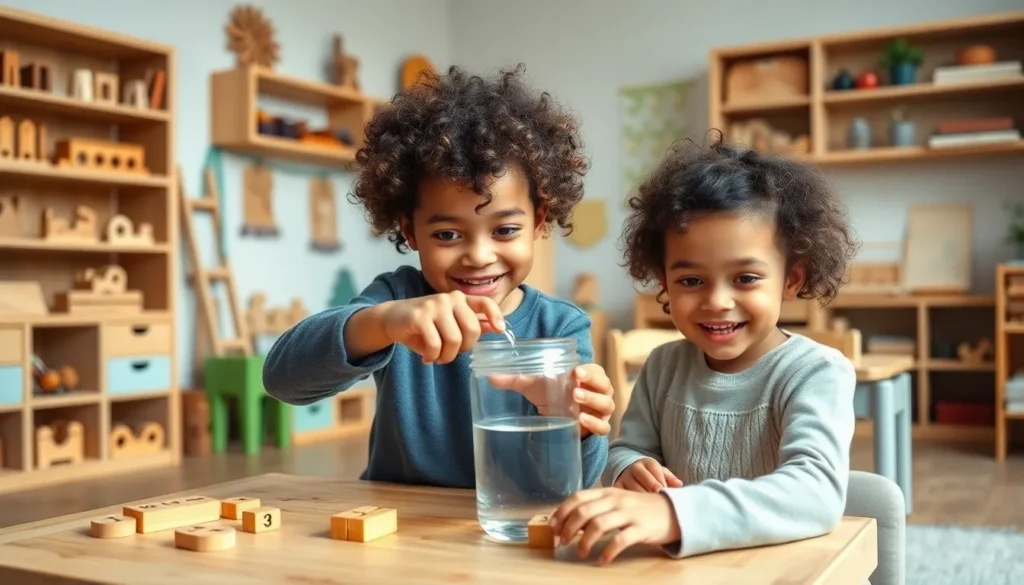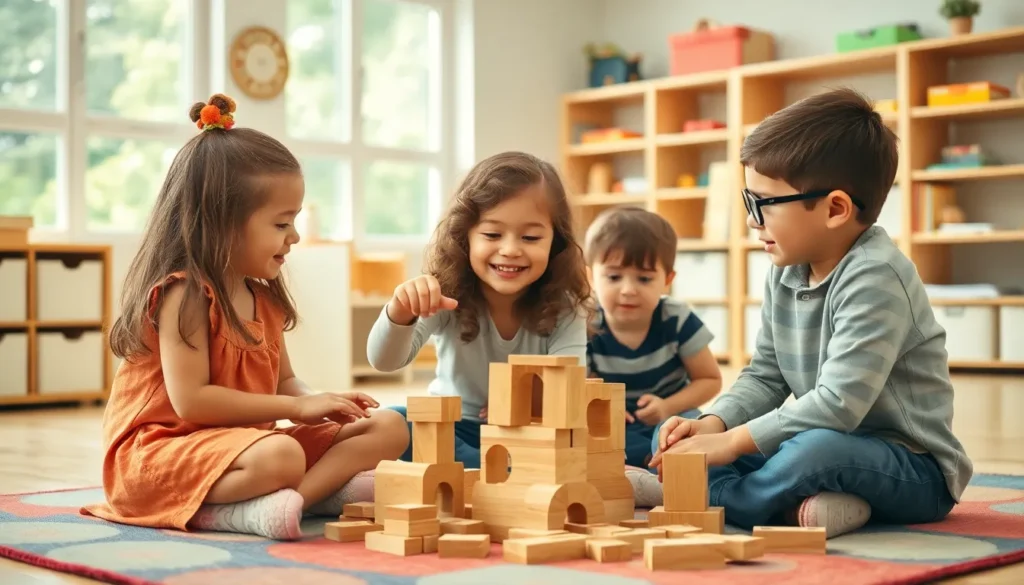Table of Contents
ToggleIn a world where traditional classrooms often resemble a scene from a chaotic circus, the Montessori classroom stands out like a serene oasis. Imagine a space where children roam freely, exploring their interests and learning at their own pace. It’s not just a classroom; it’s a carefully curated environment designed to spark curiosity and foster independence.
Setting up a Montessori classroom isn’t just about arranging furniture; it’s about creating a vibrant community where each child feels empowered. With thoughtfully selected materials and a focus on hands-on learning, this setup transforms education into an adventure. So, if you’re ready to ditch the outdated lecture-style approach and embrace a more engaging way of teaching, let’s dive into the essentials of creating a Montessori haven that even the most reluctant learners will love.
Overview of Montessori Classroom Setup
Montessori classrooms prioritize a structured yet flexible environment. Children engage with materials designed to enhance their learning experience. Each element within the space serves a specific purpose, promoting independence and exploration.
The classroom layout typically includes distinct areas for practical life, sensorial activities, mathematics, language, and cultural subjects. This arrangement allows children to choose activities based on their interests. Playful learning occurs when materials are accessible and inviting.
Furniture in a Montessori classroom serves as a vital aspect of the setup. Child-sized tables and chairs ensure comfort, enabling them to focus on tasks effectively. Classrooms feature open spaces that encourage movement and collaboration among peers.
Materials are intentionally chosen to support hands-on learning. Examples include wooden blocks, puzzles, and art supplies. These tools foster creativity and problem-solving skills as children interact with them.
Decor usually highlights natural elements and promotes a calm atmosphere. Soft colors and minimal distractions help maintain focus and serenity. Wall displays may include children’s work, inviting a sense of pride and ownership in their learning journey.
Daily routines in a Montessori classroom contribute to a predictable environment. Schedules provide structure while allowing for individual choice and pacing. This balance nurtures responsibility and self-discipline among children.
A well-organized Montessori classroom setup fosters engagement and inspires exploration. Through thoughtful arrangement and carefully selected materials, it creates a vibrant learning community where children can thrive.
Key Elements of Montessori Classroom

Montessori classrooms feature distinct elements that support self-directed learning. Creating a thoughtfully designed space significantly impacts children’s educational experiences.
Learning Areas
Learning areas have defined spaces, including practical life, sensorial, mathematics, language, and cultural subjects. Each area invites children to engage in activities that spark their interests. Children explore practical life tasks such as pouring and sorting, enhancing their independence and coordination. Sensorial activities focus on refinement of the senses, using materials that differentiate textures, colors, and sounds. Mathematics and language sections utilize hands-on materials that support abstract concepts, making learning tangible. Cultural areas introduce geography, history, and the arts, promoting global awareness. Varied activities encourage exploration, boosting confidence and fostering a love of learning.
Materials and Resources
Materials and resources play a critical role in Montessori environments, promoting engagement and discovery. Children interact with high-quality, child-sized materials that spark curiosity. Wooden blocks, puzzles, and sorting trays stimulate creativity and problem-solving skills. Each material has a purpose, supports hands-on learning, and encourages exploration. The arrangement of materials encourages independence, as children can access items without assistance. Natural elements in the decor, such as plants and soft colors, enhance focus and calmness. Well-chosen resources foster collaboration among peers, enriching social interactions through shared experiences.
Importance of Environment in Learning
The learning environment significantly influences a child’s development. It shapes experiences and nurtures curiosity.
Child-Centered Design
Child-centered design prioritizes the needs and interests of each learner. Furnishings are child-sized, ensuring comfort and encouraging engagement. Materials are carefully selected to promote autonomy. For example, practical life tasks like pouring or sweeping allow children to explore valuable skills. Shelves showcase easily accessible learning tools, inviting exploration whenever a child feels inspired. Each area, from language to mathematics, features specialized resources that cater to various learning styles. This thoughtful arrangement transforms the classroom into an inviting space where children feel empowered to learn at their own pace.
Flexibility and Accessibility
Flexibility and accessibility foster exploration and creativity in a Montessori setting. Open spaces encourage movement, allowing children to choose their paths and activities. Classroom layouts can adapt to the needs of different learners, promoting collaboration and interaction. Accessibility remains crucial, as learning materials are organized for easy reach. Children can independently select and return items, reinforcing responsibility. Daily routines incorporate flexibility, enabling adjustments that suit the classroom’s dynamic nature. An adaptable environment supports growth and discovery, aligning with the Montessori philosophy of self-directed learning.
Benefits of Montessori Classroom Setup
Montessori classroom setups offer numerous advantages for children’s learning experiences. These benefits help cultivate a nurturing and effective educational environment.
Fostering Independence
Independence flourishes in a Montessori classroom. Children engage in practical life activities that develop essential skills. Tasks such as pouring or sweeping empower kids to take ownership of their learning. Accessibility to materials encourages exploration without adult intervention. As children choose their activities, they learn decision-making skills. Building confidence becomes a natural progression as they succeed in self-directed tasks. This autonomy enhances motivation and instills a sense of responsibility.
Promoting Collaborative Learning
Collaboration thrives in Montessori settings. Group activities encourage teamwork, fostering social interactions among peers. Mixed-age groups allow younger children to learn from their older classmates, promoting mentorship. Open spaces facilitate group discussions and collaborative projects, nurturing communication skills. Opportunities for joint problem-solving enhance critical thinking abilities. Children learn to respect diverse perspectives as they work together. The collaborative nature of these environments builds a strong sense of community, enriching the overall educational experience.
Challenges in Implementing Montessori Setup
Implementing a Montessori classroom setup presents distinct challenges that stakeholders must navigate. These challenges can hinder the successful establishment of an effective learning environment.
Space Limitations
Space limitations often constrain the setup of a Montessori classroom. Available square footage impacts the arrangement of distinct learning areas. When classrooms are smaller, creating separate zones for practical life, sensorial activities, and cultural subjects becomes difficult. Limited space restricts the number of accessible materials, ultimately impeding children’s ability to choose activities freely. Optimally designed classrooms thrive on openness, which fosters movement and collaboration, but physical constraints can reduce that essential fluidity. Working within confined spaces demands creative solutions to maintain a Montessori philosophy.
Training and Resources
Training and resources play a critical role in implementing a Montessori setup. Teachers require specialized training to effectively facilitate this unique learning approach. Insufficient training can lead to misunderstandings of the methodology, resulting in ineffective classroom management. Access to quality educational resources is equally significant; without appropriate materials, children may struggle to engage with the curriculum. Continuous professional development opportunities can strengthen teachers’ skills, ensuring they remain aligned with Montessori principles. Investing in comprehensive training and resources promotes confidence, enabling educators to create enriching environments where children flourish.
A well-designed Montessori classroom setup can transform the learning experience for children. By prioritizing independence and collaboration it fosters an environment where curiosity thrives. The intentional arrangement of materials and furniture encourages exploration and hands-on learning.
Creating distinct areas for various subjects allows children to engage deeply with their interests while developing essential life skills. Though challenges in implementation exist investing in proper training and resources is crucial.
Ultimately a Montessori classroom not only nurtures academic growth but also cultivates a sense of community and responsibility among learners. Embracing this approach can lead to a more enriching educational journey for every child.







